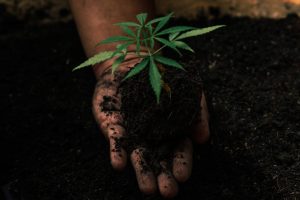
Many farmers rushing in to profit from hemp over the past few years were burned badly.
Some recorded massive economic losses because of the learning curve associated with the plant, others because contracts or processors fell through. Still more suffered crop loss, a perennial risk in agriculture.
Hemp advocates are looking for ways to convince burned farmers to grow it again, and a focus on hemp’s potential role in regenerative agriculture might be the key.
According to the European Industrial Hemp Association, the crop is twice as effective at carbon sequestration as trees and gobbles carbon at a rate of 6 tons per acre.
But to change minds about hemp and its role in regenerative agriculture, a paradigm shift is required, both within the hemp industry and in the broader agricultural production front, hemp advocates said during a recent event produced by Regennabis, a San Francisco-based sustainable business consultancy.
“There’s a check box of … regenerative practices that needs to be added to every enterprise in the world, in every field,” said Doug Fine, a New Mexico hemp producer, author and activist.
“You’re either part of the solution and reversing where we’re going, or our grandkids don’t have a planet. It’s the ninth inning, two outs.”
Hemp and carbon
National policies to incentivize carbon capture in the climate change battle could be a big win for hemp farmers.
But while hemp is often touted as a crop that sequesters tons of carbon, the data points aren’t always reliable, said Annie Rouse, chief operating officer of hemp formulations company OP Innovates in Lexington, Kentucky.
“You really have to be careful to think about the variety that you’re growing, because some of the data that’s out there might be an average,” she said.
“Some of it might be the best of the best, which might not be what you are actually sequestering with the varieties that you have.”
On the other hand, hemp doesn’t have many approved crop-protection products, such as herbicides or pesticides that are “very carbon-emitting,” so it is a less environmentally costly crop, Rouse said.
Farmers growing hemp with regenerative practices can reduce synthetic nitrogen inputs with natural products such as animal waste.
“If you’re going to grow it using business-as-usual practices, like we do soy and corn, you’re going to be using synthetic fertilizers, (which) create nitrous oxide,” a gas that has 300 times the global warming potential of carbon dioxide and impacts the full carbon lifecycle of the plant, she said.
Another thing to consider is the longevity of carbon capture.
Hemp being produced for the cannabinoid market that is packaged in plastic, which may be discarded, has a different level of carbon capture than hemp that is used in building or concrete.
“In order to have carbon capture, really, it needs to be at least 100 years,” she said.
Federal incentives, whether addressing carbon sequestration or mandating hemp proteins in schools, will go a long way toward growing the hemp industry, Rouse said.
“And if we can do it sustainably, then that’s the future of the industry,” she said. “We only have one chance to do this right, so why not do it right?”
Measuring carbon capture
Gary Chavez, vice president and director of science, advanced carbons, at hemp producer Santa Fe Farms in New Mexico, pointed to a study by the Australian government that gives an idea of how much of an offset is provided from sequestering carbon in forests.
But growing cannabis is different from growing trees in that hemp roots can drive six times deeper than some tree roots, Chavez said.
“That’s six times more potential for us to drive carbon into the earth,” Chavez said.
The process starts with the fungi and bacteria within the soil.
The way the agriculture industry farms with nitrogen currently adds to global warming, so by sequestering carbon in the soil, farmers also keep fungi and bacteria in the soil, which might, in turn, remediate conventional crop-protection chemicals, Chavez said.
“What if we, rather than fight the chemical companies, figure out how to remediate their chemicals into an organic model, and that’s where it really transitions from traditional N-P-K (nitrogen, phosphorus, potassium) measurements on our macro-micro scales,” he said.
“Let’s look at the excavates and figure out what these microbes are pumping out.”
For example, bean-management studies show the ability to balance the fungi-bacteria ratio to handle multiple forms of nitrogen.
Because of the nascent nature of the industry, hemp genetics haven’t been manipulated much yet, which is fortunate, Chavez said.
“Getting to that epigenetic level on hemp is huge. We can tease that to each region and look at which ones are actually sequestering carbon,” he said.
Getting hemp into the field as a rotational crop to move agricultural systems to a polyculture farming approach will be where the real shift occurs in regenerative agriculture, according to Chavez.
Farmer incentives
Fields must be farrow for three years after using conventional farming practices before they can be certified organic, making it difficult to transition, Rouse said.
Often, farmers transition their farms one section at a time, which adds to the economic burden associated with what already can be a multiyear process.
Policymakers can motivate farmers to move away from monoculture models by reducing the expense or providing grants for producers to transition from conventional farming to organic to regenerative farming, or directly to regenerative practices, Rouse said.
Additionally, reducing or halting subsidies for traditional row crops, such as corn and soy, could help put hemp on an even playing field to “make the dramatic shifts in our agricultural systems that we need so desperately to survive,” she said.
“What we’re buying products for on the shelf is not the true value of what it cost to get there, and part of that is because the environment was never factored into the cost of a good. And that’s a tremendous problem at a global scale.”
Laura Drotleff can be reached at [email protected]

